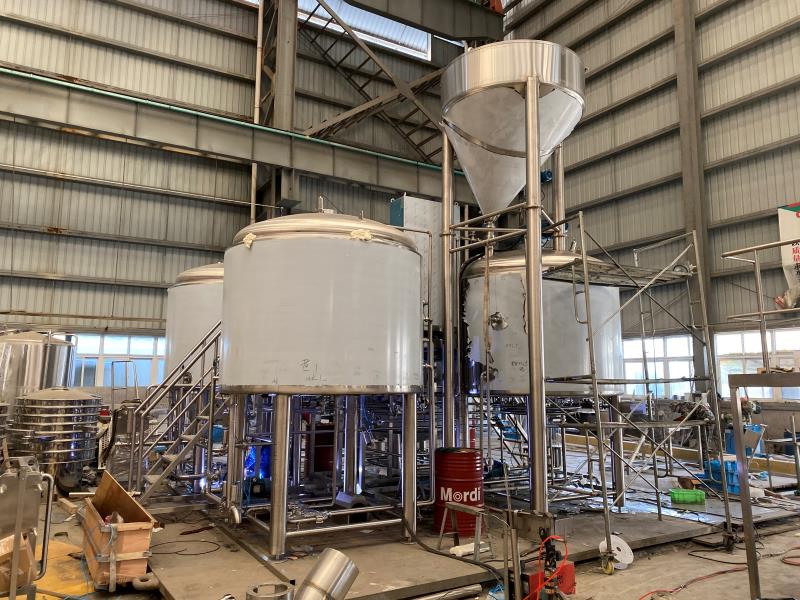The History Of The Brewhouse
The term “brewhouse” typically refers to a facility or building where beer is produced. The history of brewhouses dates back thousands of years to the origins of beer itself. Let’s explore the evolution of brewhouses over time:
Ancient Origins:
Beer brewing can be traced back to ancient civilizations, such as Mesopotamia (modern-day Iraq) and ancient Egypt. In these early times, brewing beer was often a household activity, with individuals brewing small batches for personal consumption. The brewhouses of this era were simple and consisted of basic tools and equipment, such as clay pots, stone vessels, and fermentation jars.
Medieval Europe:
During the Middle Ages, brewing beer became an important industry in Europe. Monasteries played a significant role in advancing brewing techniques and establishing larger-scale brewhouses. Monks developed recipes and methods for brewing beer, and their brewhouses became central hubs of production. These early European brewhouses featured large copper kettles for boiling the ingredients and wooden barrels for fermentation and storage.
Industrial Revolution:
With the advent of the Industrial Revolution in the 18th century, brewing underwent significant changes. The rise of steam power and industrial machinery transformed the brewing process. Large-scale breweries emerged, necessitating larger and more efficient brewhouses. Industrial brewhouses incorporated technological advancements, such as steam-powered mash tuns and mechanical systems for milling grain. These developments increased the speed and efficiency of beer production.
Modern Era:
In the 20th century, brewhouses continued to evolve with advances in technology and brewing science. Stainless steel replaced traditional materials like copper and wood, providing improved hygiene, temperature control, and ease of cleaning. Automation and computerization further streamlined the brewing process. Modern brewhouses often feature automated control systems, precise temperature regulation, and sophisticated equipment for mashing, lautering, boiling, and fermenting.
Craft Brewing Renaissance:
In recent decades, there has been a resurgence of craft breweries, bringing back smaller-scale, artisanal brewing. Craft brewers often design their brewhouses to reflect their creativity and style. Many craft breweries prioritize manual labor and hands-on techniques, using smaller and more specialized equipment. These brewhouses may incorporate unique features and experimental brewing methods to create a wide range of beer styles.
The Perfect Brewhouse Setup:
The perfect brewhouse setup can vary depending on the specific needs and goals of a brewery, but here are some key elements that are often considered essential:
- Space and Layout:
A well-designed brewhouse requires sufficient space to accommodate all the brewing equipment, tanks, and necessary workflow. It should have a logical and efficient layout that allows for smooth movement of ingredients and personnel during the brewing process. Adequate space should be allocated for each brewing stage, including milling, mashing, boiling, fermentation, and packaging.
- Brewing Equipment:
High-quality brewing equipment is crucial for a successful brewhouse setup. This typically includes a range of vessels such as mash tuns, lauter tuns, brew kettles, fermenters, and conditioning tanks. The equipment should be appropriately sized for the brewery’s production volume and designed to provide precise temperature control, efficient heating and cooling, and easy cleaning via C.I.P. (Clean In Place)
- Water Supply and Treatment:
Water is a vital ingredient in beer production, and a reliable and consistent water supply is essential. The brewhouse should have access to an ample water source, preferably with good quality water suitable for brewing. Additionally, the ability to treat and adjust the water’s mineral content and pH levels is advantageous for achieving desired beer styles.Often created with R.O. & a light salt bill to produce enhanced flavors.
- Grain Handling and Milling:
Efficient grain handling and milling equipment are crucial for breaking down malted grains and preparing them for the brewing process. A brewhouse should have a dedicated space for storing and handling grains, along with a grain mill capable of producing a consistent and uniform grain crush. Proper grain milling ensures efficient extraction of sugars during mashing. While mitigating risk of fire the separation is often mandatory do to regulations.
- Temperature Control:
Maintaining precise temperature control throughout the brewing process is essential for achieving desired flavors and aromas in beer. A well-equipped brewhouse should have a system in place to regulate temperatures during mashing, boiling, fermentation, and conditioning. This may include heat exchangers, glycol chilling systems, or steam generators, depending on the brewery’s scale and requirements.
- Sanitation and Cleaning:
Maintaining a high level of cleanliness and sanitation is crucial in any brewhouse. It should have a designated area for cleaning and sanitizing equipment, including tanks, piping, and hoses. Adequate drainage systems and appropriate cleaning agents should be available to ensure the brewhouse remains hygienic and free from contaminants. Pulse C.I.P are amazing at remove the tough to get particles and oil build ups for the process.
- Quality Control and Laboratory:
A dedicated space for quality control and a small laboratory can be beneficial for monitoring and testing beer throughout the brewing process. This allows brewers to analyze key parameters like gravity, pH, dissolved oxygen levels, and yeast cell counts. Quality control measures help ensure consistency and excellence in the final product.
- Packaging Area:
If the brewery plans to package beer on-site, a designated area for bottling, canning, or kegging should be included in the brewhouse setup. This area should be equipped with appropriate packaging machinery, labeling systems, and storage space for finished products.
It’s important to note that the perfect brewhouse setup will also depend on factors like production volume, beer styles produced, available budget, and the specific preferences of the brewers. Customization and flexibility are often key in tailoring the brewhouse to meet the brewery’s unique needs and goals.
Today, brewhouses vary greatly in size, design, and functionality. They can range from small-scale operations in brewpubs and microbreweries to large industrial breweries with extensive production capabilities. The brewhouse remains a vital component of the beer production process, where the art and science of brewing converge to create the beloved beverage enjoyed worldwide.

